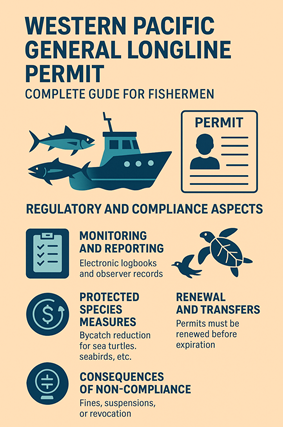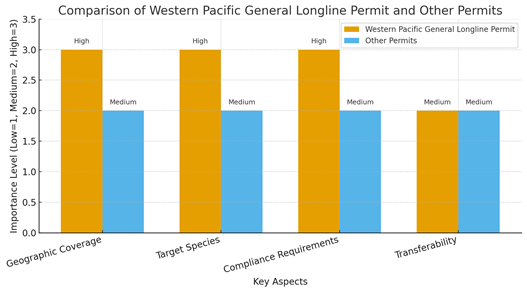Commercial fishing is one of the most important industries in the Pacific Islands. To be legally permitted to work in this competitive sector of the economy, fishing vessel owners need to get a Western Pacific General Longline Permit. The permit allows using longline gear toward catching highly migratory fish like tuna and swordfish in parts of the Western Pacific.
The law requires a Western Pacific General Longline Permit for fishing in the region under it, yet it also lets people fish responsibly and sustainably. Without one, operators risk fines, restrictions, or the loss of fishing rights in total. It permits people to participate in regulated fisheries, balancing the potential economic opportunities with conservation benefits.
What is the Western Pacific General Longline Permit?
The National Marine Fisheries Service (NMFS) issues the Western Pacific General Longline Permit to fish for highly migratory fish species in the Exclusive Economic Zones of U.S. Territories in the Pacific Ocean waters surrounding American Samoa, Guam, Hawaii, and the Northern Mariana Islands.

Objectives of the Permit
- Regulate Pacific pelagic fisheries access.
- Lessen fishing that is illegal, unreported, and unregulated.
- Sustainably manage tuna and other highly migratory stocks throughout.
- Support regional economies and fishing communities.
Information Required in the Application
The application process requires vessel-specific and ownership data.
| Section | Description | Required Documents |
|---|---|---|
| Vessel Information | Length, tonnage, gear type, and home port | Vessel Documentation Certificate |
| Owner Details | Names, addresses, and legal status | Government-issued ID |
| Fishing Operations | Intended fishing areas and target species | Fishing Operation Plan |
| Compliance Records | Past permit history and compliance status | NMFS Compliance Confirmation |
This information ensures that only qualified, compliant operators gain access to highly valuable fisheries.
Regulatory and Compliance Aspects
Strict compliance with fishery management measures is required to prevent the Western Pacific General Longline Permit from being revoked.
Monitoring and Reporting
Logbook and observer data and landing reports are required to be submitted to the NMFS, which intends to transition to electronic logbooks to collect data.
Protected Species Measures
The permit includes measures for reduction of bycatch of sea turtles, seabirds and marine mammals. Longline vessels must use gear modifications and safe handling methods for marine animal protection.
Renewal and Transfers
Permits must be renewed before they expire, and some can be transferred according to rules adopted from the National Marine Fisheries Service (NMFS).
Consequences of Non-Compliance
Failure to fulfill conditions of the permit may result in a fine, permit suspension or revoked fishing rights.
Comparing the General Longline Permit with Other Fishing Permits
The Western Pacific General Longline Permit is one of many permits in the regulatory structure, and has a different scope to the others.
General Longline vs. Hawaii Longline Permit
Both permits allow for longline fishing, but the Hawaii Longline Permit restricts the area where fishing is allowed while the General Longline Permit has more regional fishing opportunities.

- Western Pacific Longline Permit: Broad geographic range and compliance requirements.
- Hawaii Longline Permit: High target species, medium coverage.
- Other Permits: Vary by region.
This reflects the value of the General Longline Permit, which allows operators to seek access across multiple territories.
Step-by-Step Guide to Obtaining a Western Pacific General Longline Permit
The application procedure can be challenging, but if you follow a simple plan, it may be simpler.
Verify Eligibility
Verify vessel documentation, ownership, and compliance history.
Collect Documentation
Collect vessel certificates, ownership IDs, and historical compliance records.
Complete Application Forms
Specifications, intended use, and compliance declarations for vessels.
Submit Application and Fees
Applications must be submitted to NMFS by the required deadline with applicable fees.
Maintain Compliance
Once operators are granted permits, they must comply in record keeping, reporting and conservation measures.
Why the Western Pacific General Longline Permit Matters
Commercial Fishing Permits Center is the principal commercial permit allowing access to highly migratory species in the Pacific Islands. It includes provisions for conservation and monitoring of fishery practices. To vessel owners and fishing companies, the permit offers some measure of legitimacy, security, and opportunity in a difficult, risky business.
Operators in the fishery complete applications, report landings and comply with conservation and management measures. The permit is a critical administrative requirement to show economic viability and good stewardship for a responsible fishing industry in the Western Pacific region.


No Comments
Be the first to start a conversation